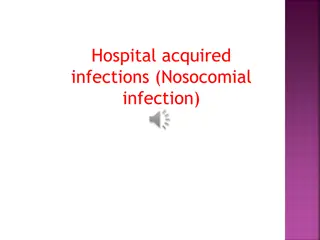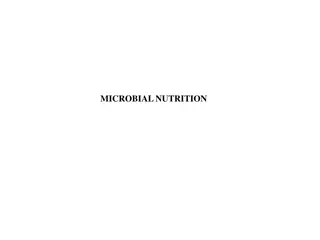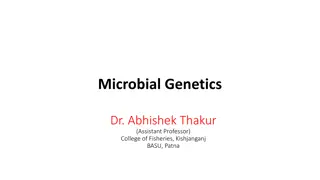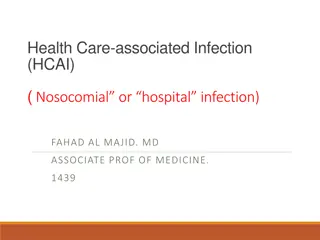Understanding Anaemia and Infections in Relation to Health
Anaemia can result from various causes such as blood loss, increased destruction of red blood cells, and impaired production, often linked to infections and chronic diseases. Parasites, bacteria, and viruses play a role in the progression of anaemia, affecting the body's ability to produce and utili
3 views • 10 slides
Understanding Nontuberculous Mycobacteria Infections in Cystic Fibrosis
Nontuberculous mycobacteria (NTM) infections present a significant challenge in individuals with cystic fibrosis (CF). These infections are caused by over 200 species of atypical mycobacteria found in various environments. The CF-ID Clinic plays a crucial role in managing patients with multi-drug re
2 views • 25 slides
Understanding Nosocomial Infections and Prevention Strategies
Nosocomial infections are microbial diseases that affect patients during hospital stays, with sources including patients, healthcare workers, and hospital environments. Investigations involve isolating organisms and typing them for efficient management. Prevention strategies include sterilization, h
10 views • 8 slides
Anaerobic Bacterial Infections: Overview and Clinical Implications
Anaerobic bacterial infections are caused by bacteria that do not require oxygen for growth, posing challenges in diagnosis and treatment. This article delves into the types of anaerobic bacteria, their role in human infections, and common clinical presentations such as abscess formation. Gram-negat
2 views • 24 slides
Understanding the Rhizosphere: A Historical and Microbial Perspective
The rhizosphere, the region surrounding plant roots, harbors a diverse community of microorganisms influenced by plant roots. Historical background and microbial interactions in the rhizosphere are explored, highlighting the favorable habitat for microbial proliferation and metabolism. Various techn
1 views • 49 slides
Understanding Fungi Diversity and Infections in Microbiology
Explore the world of fungi and fungal infections in this foundation block of microbiology. Learn about medically important yeasts, mold fungi, major fungal diseases, antifungal agents, and infection acquisition methods. Dive into hypersensitivity reactions, mycotoxicoses, and various types of fungal
1 views • 19 slides
Understanding Microbial Nutrition and Bacterial Physiology
Microbial nutrition involves essential elements required for microbial growth and energy production. Bacterial physiology delves into the structures and functions that enable bacteria to thrive, from cell wall composition to enzyme activities. Major elements like C, O, H, N, S, and P are crucial for
2 views • 20 slides
Understanding Microbial Nutrition and Growth Factors
Microbes require carbon for metabolic activities, with organisms categorized as heterotrophs or autotrophs based on their carbon source. In addition to carbon, macronutrients like nitrogen, phosphorous, sulfur, potassium, and magnesium are crucial for cell function. Growth factors such as amino acid
0 views • 15 slides
Understanding Microbial Genetics and Mutations in Organisms
Explore the world of microbial genetics with Dr. Abhishek Thakur, an Assistant Professor specializing in Microbial Genetics at the College of Fisheries, Kishjanganj, BASU, Patna. Learn about important concepts such as strains, clones, genome, phenotype, genotype, genes, genetic recombination, and mu
0 views • 19 slides
Understanding Virus-Cell Interactions and Infections
Viral infections exhibit diverse cellular tropism based on receptor interactions, impacting cell function through modulation and potential host defense responses. Infections can lead to various outcomes, from cell death to persistent or latent states, with nuanced effects on cellular behavior. Diffe
0 views • 8 slides
Understanding Antiamebic Drugs: A Guide to Managing Protozoal Infections
Protozoal infections, such as amebiasis, are a significant concern globally. In underdeveloped regions and beyond, these infections pose challenges due to inadequate sanitation and hygiene practices. Antiamebic drugs are essential for treating conditions like amebiasis, caused by Entamoeba histolyti
0 views • 40 slides
Methods for Determination of Microbial Growth
Quantitative determination of microbial growth is crucial for various purposes, with two commonly used methods being the standard plate count and spectrophotometric measurement. The standard plate count method estimates living microbial cell density, while spectrophotometric measurement relies on tu
2 views • 6 slides
Understanding Microbial Ecology: Interactions and Associations in Ecosystems
Interactions of organisms in ecosystems play a crucial role in the functioning of microbial ecology. Dr. Abhishek Thakur explores symbiosis, mutualism, syntrophism, commensalism, predation, and parasitism, shedding light on how different organisms interact with each other and their physical environm
0 views • 9 slides
Importance of Surgical Head Coverings in Preventing Surgical Site Infections
Surgical head coverings play a crucial role in preventing surgical site infections by reducing the risk of microbial contamination and transmission in the operating room environment. Guidelines recommend covering the head, hair, and ears to minimize the shedding of microorganisms from surgical staff
0 views • 10 slides
Mechanisms of Nutrient Uptake by Microbial Cells
Nutrient uptake by microbial cells involves various transport mechanisms such as passive diffusion, facilitated diffusion, active transport, and group translocation. These mechanisms ensure the specific acquisition of required nutrients by the cell through the selectively permeable plasma membrane.
3 views • 15 slides
Understanding Anthelmintics: Drug Therapy for Parasitic Worm Infections in Veterinary Medicine
Anthelmintics are essential drugs to combat parasitic worm infections in animals. They work either by killing (vermicide) or expelling (vermifuge) the worms, reducing worm burdens and controlling infections. This comprehensive overview covers different aspects of anthelmintics, including their prope
2 views • 34 slides
Understanding the Normal Microbial Flora of the Human Body
The normal microbial flora, also known as the indigenous microbiota, inhabit various areas of the human body such as the gastrointestinal tract, respiratory tract, genitourinary tract, and skin. They play a crucial role in maintaining health and can re-establish themselves when disturbed. While resi
0 views • 22 slides
Understanding the Treatment of Respiratory Tract Infections: Antibiotics and Management
This lecture covers the classification of respiratory tract infections and the antibiotics commonly used to treat them. It highlights the types of infections caused by viruses and bacteria, along with their respective treatments. The mechanism of action and pharmacokinetics of antibiotics, such as p
0 views • 7 slides
Understanding Microbial Nutrition and Essential Elements
Microbial nutrition is crucial for the growth and functioning of microorganisms, requiring various elements in different quantities to construct cellular components and obtain energy. Major elements like carbon, oxygen, hydrogen, nitrogen, sulfur, phosphorus, and others play vital roles in microbial
0 views • 20 slides
Factors Affecting Microbial Growth in Foods
Moisture content and pH levels are key factors influencing the growth and survival of microorganisms in foods. The water activity (aw) of food substrates affects microbial growth, with bacteria and fungi having varying requirements. Lowering aw below optimum levels can increase the lag phase of grow
2 views • 15 slides
Multidimensional Optimality of Microbial Metabolism
Exploring the multidimensional optimality of microbial metabolism through metabolic network analysis, C-based flux analysis, and stoichiometric reaction modeling. The concept of Pareto optimal solutions in multi-objective optimization problems is discussed in the context of microbial metabolic pathw
0 views • 22 slides
Innovative Hygienic Solution for Healthcare Facilities: Introducing Medi-ShowerTM
Multi-Shower GB has developed the award-winning Medi-Shower, a unique anti-microbial showering system designed for healthcare facilities. Featuring color-coded Medi-Flush inserts, quarterly maintenance, and continual protection from bacteria, Medi-Shower provides a comprehensive solution to address
0 views • 11 slides
Effects of Spicy Foods on Pathogenic Microbial Growth: A Study on Rosemary and Clove
Spicy foods like rosemary and clove have shown potential in inhibiting pathogenic microbial growth, which can help enhance food safety by reducing the need for chemical additives. This study explores the antimicrobial effects of these spices using microbial strains like Pseudomonas Fluorescens and S
0 views • 14 slides
Understanding Health Care-associated Infections (HCAI) in Hospital Settings
Health care-associated infections (HCAI), also known as nosocomial or hospital infections, are infections that occur in patients during their hospital stay or after discharge. These infections can result from various sources, including colonization by microorganisms and exposure to contaminated envi
0 views • 48 slides
Advancing Microbiological Systems Through Genetic Engineering and Microbial Community Engineering
Exploring the intersection of genetic engineering and microbial community engineering to enhance electron bifurcation systems. Addressing trade-offs between synthetic biology and wildtype organisms, incorporating microbial community engineering in Synbio, and investigating CO2 metabolism in the abse
0 views • 8 slides
Overview of Eye, Ear, Nose, and Throat Infections by Nenad Pandak
In this comprehensive guide by Nenad Pandak, various aspects of eye, ear, nose, and throat infections are discussed. The content covers infections such as conjunctivitis, keratitis, pharyngitis, otitis media, and sinusitis. It also delves into causes, clinical presentations, and diagnosis of these i
0 views • 68 slides
Understanding Respiratory Tract Infections: Causes and Prevention
Respiratory tract infections are commonly caused by viruses, bacteria, rickettsia, and fungi, leading to various health issues. These infections can be transmitted through droplets, droplet nuclei, and dust, emphasizing the importance of maintaining respiratory health through specific and non-specif
0 views • 34 slides
MicrobeDB Database Analysis for Microbial Diversity
In June 2017, data from MicrobeDB.jp was analyzed, revealing microbial diversity in various phyla and families. The study included Wilcoxon P-values and abundances of different microbial genera. The analysis indicated the presence of various bacterial and archaeal species in different environments,
0 views • 20 slides
Understanding Viral Infections of the Respiratory System
Respiratory viral infections are common and primarily caused by viruses, leading to morbidity and time off work. They can range from mild upper respiratory tract infections to severe lower respiratory tract infections like pneumonia. Various viruses like influenza, parainfluenza, respiratory syncyti
0 views • 23 slides
Microbial Isolation Techniques and Methods
This content provides a detailed guide on the isolation of microbes from various environments using techniques such as sample introduction, inoculation, incubation, inspection, and identification. It includes information on the use of an incubator, materials, and methods required for microbial isola
0 views • 13 slides
Principles of Food Spoilage: Understanding Microbial and Nonmicrobial Factors
Explore the principles of food spoilage in the context of microbial and nonmicrobial influences. Topics covered include classification of foods based on stability, types of agents causing spoilage, prevention practices, and the criteria for acceptability of food. Learn about microbial growth, enzyme
0 views • 19 slides
Understanding Common Infections in Nursing Home Residents
Explore the causes, types, and impact of infections in nursing home residents while learning how to prevent and control infections. Discover common infections, factors contributing to infections, and resident rights in infection control practices.
0 views • 23 slides
Understanding Diabetic Foot Infections and Associated Risks
Diabetic patients are prone to infections, significantly impacting morbidity and mortality rates. Increased infection risk is due to both host-related and organism-related factors. Common infections in diabetic patients include skin and soft tissue infections, diabetic foot infections, respiratory t
0 views • 14 slides
Preventing Catheter-Associated Urinary Tract Infections
This presentation covers the prevention of catheter-associated urinary tract infections (CAUTIs) in healthcare settings. It highlights the significance of urinary tract infections, risk factors, preventive measures, and common microbiology involved. Key topics include the importance of urine collect
0 views • 34 slides
Microbiology of Bone and Joint Infections: Comprehensive Overview
This lecture delves into the microbiology of bone and joint infections, covering important aspects such as definitions, pathogenesis, causative agents, diagnosis, and management of osteomyelitis and arthritis. It emphasizes the commonality of these infections in infants and children, highlighting ri
0 views • 29 slides
Understanding Microbial Growth: Phases and Dynamics
Microbial growth is defined as an increase in cellular constituents leading to a rise in microorganism size or population. The growth of bacterial cells is characterized by distinct phases such as lag phase and exponential phase. During the lag phase, cells are synthesizing new components before div
0 views • 21 slides
Understanding Aquatic Microbial Groups and Their Environments
Explore the diverse world of aquatic microbial groups, their distribution in different water bodies, and their roles in ecosystems. Learn about the factors influencing microbial growth in water, the impact of eutrophication, bioremediation strategies, and the unique microbial communities found in es
0 views • 18 slides
Understanding Anti-Microbial Agents and Their Applications
Anti-microbial agents, including antiseptics, disinfectants, and germicides, play a crucial role in preventing infections and promoting public health. They can inhibit the growth of pathogenic micro-organisms on living tissues, objects, and materials. Sterilization ensures complete destruction of al
0 views • 16 slides
Managing Catheter-Related Bloodstream Infections in Vascular Access
Reduce and prevent catheter-related bloodstream infections in vascular access by addressing extraluminal infection sources and implementing strategies outlined in national drivers such as the NHS Long Term Plan and the Antimicrobial Resistance Action Plan. Recognize the importance of tackling antimi
0 views • 25 slides
Understanding Acute and Chronic Inflammation: Causes, Outcomes, and Resolution
Acute inflammation results in either resolution or progression to chronic inflammation, with outcomes like restoration of normalcy, fibrosis, or scarring. Chronic inflammation can be caused by viral infections, persistent microbial infections, exposure to toxic agents, or autoimmune diseases. Macrop
0 views • 27 slides







































